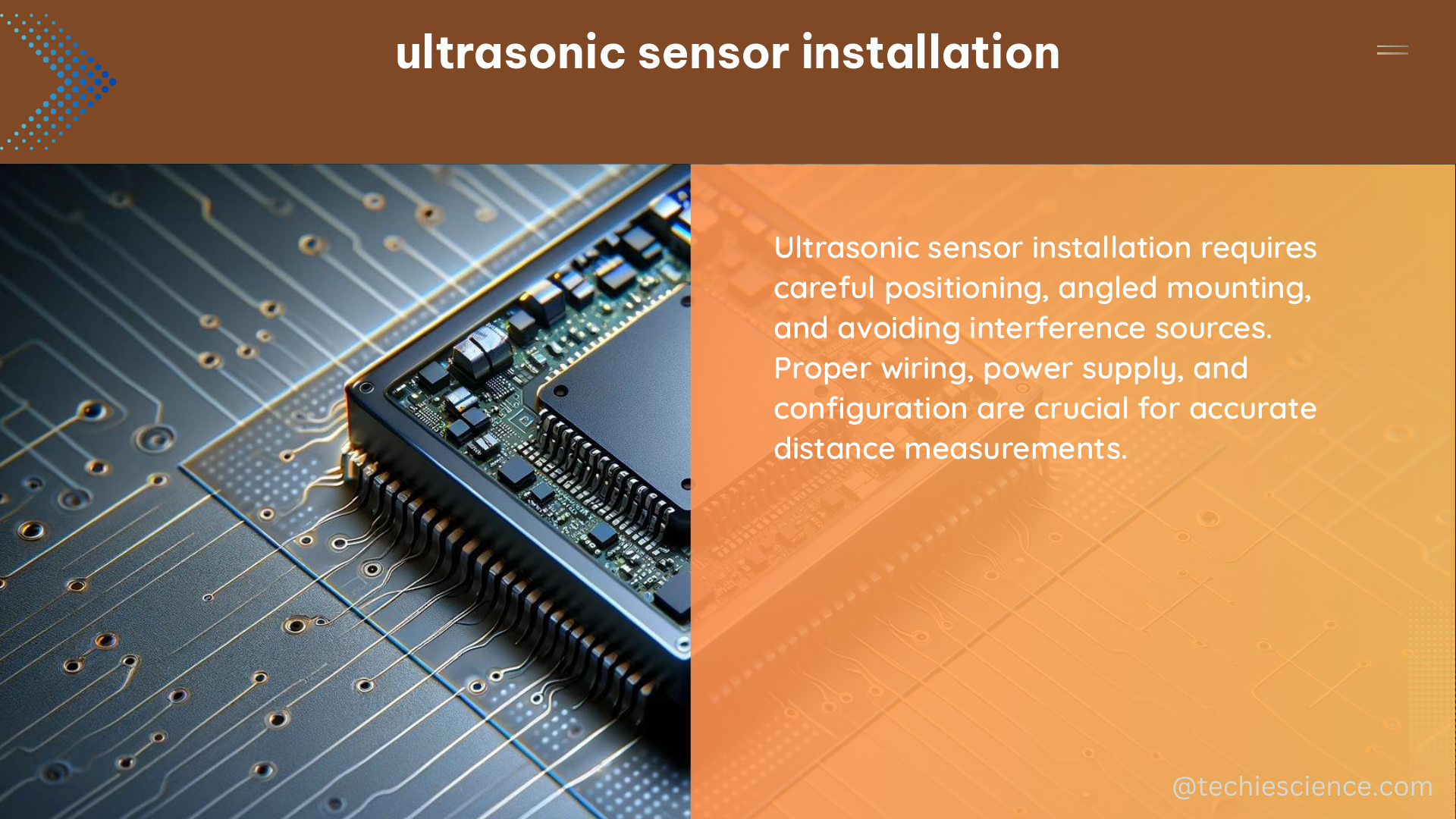Ultrasonic sensor installation is a critical process that requires meticulous attention to technical specifications and careful calibration. These sensors emit sound waves and measure the time it takes for the sound to bounce back, allowing them to calculate distance. The installation angle, mounting spacing, and synchronization are all essential factors to consider for accurate and reliable distance measurements.
Optimal Installation Angle
When installing ultrasonic sensors, it is recommended to mount them at a 90 ± 3° angle to flat and smooth surfaces. This ensures the sound waves are perpendicular to the target surface, maximizing the sensor’s detection capabilities. However, for rough surfaces, larger angular deviations of up to ±10° can be tolerated without significantly impacting the sensor’s performance.
It is important to note that the sensor’s function can be impaired by drops of water and severe deposits on the surface of the transducer. Small dust deposits and splashes of paint typically do not affect the sensor’s operation. Additionally, sound-absorbent materials can reduce the sensor’s operating range, while liquids and solid materials are good reflectors of sound.
Mounting Spacing and Synchronization

Mounting spacing and synchronization are critical factors to consider when installing multiple ultrasonic sensors. If two or more sensors are mounted too close to each other, they can influence one another, leading to inaccurate distance measurements. To avoid this, the mounting spacing must be sufficiently large, or the sensors must be synchronized.
The minimum mounting distance between unsynchronized sensors depends on the sensor’s operating range. As a general rule, the minimum mounting distance should be at least twice the sensor’s maximum operating range. For example, if the sensor has a maximum range of 5 meters, the minimum mounting distance between unsynchronized sensors should be at least 10 meters.
Technical Specifications and Capabilities
Ultrasonic sensors offer several advantages over optical sensor technologies. They can detect colored, shiny, or transparent surfaces that can be challenging for optical sensors. These sensors can be used for product detection and ranging, and they can operate at a fixed sampling frequency of 100 Hz, providing 12-bit resolution and continuous measurement with a conversion time of 100 ns in stable conversion.
Sensor Calibration
Calibrating the ultrasonic sensor is a crucial step in ensuring its accuracy and linearity of measurement. To calibrate the sensor, it is important to test it at different distances and determine its linearity of measurement. A common approach is to take 100 distance samples at each of five distance points (12, 25, 38, 50, and 63 cm), which can help determine the sensor’s accuracy and linearity.
During the calibration process, it is essential to consider the impact of temperature and humidity on the sensor’s performance. Changes in these environmental conditions can affect the speed of sound, which can, in turn, impact the sensor’s distance measurements. To address this, you may need to use temperature and humidity sensors in conjunction with the ultrasonic sensor or implement temperature and humidity compensation algorithms in the sensor’s firmware.
Conclusion
Ultrasonic sensor installation requires a meticulous approach to ensure accurate and reliable distance measurements. By following the guidelines outlined in this comprehensive guide, you can properly install and calibrate your ultrasonic sensors, taking into account factors such as installation angle, mounting spacing, synchronization, and environmental conditions. With the right technical knowledge and attention to detail, you can maximize the performance of your ultrasonic sensors and achieve the desired results in your applications.
References:
- James Madison University. (2022). Lab 4 Ultrasonic Sensors – ISAT 300 Spring Semester, 2022 Section. Retrieved from https://www.studocu.com/en-us/document/james-madison-university/applied-computing-instrumentation-and-measurement-in-science-and-technology/lab-4-ultrasonic-sensors/38492740
- DigiKey. (2022). Product Detection and Ranging Using Ultrasonic Sensors. Retrieved from https://www.digikey.com/en/articles/product-detection-and-ranging-using-ultrasonic-sensors
- National Center for Biotechnology Information. (2019). Quantifiable and feasible estrus detection using the ultrasonic sensor array and digital infrared thermography in sows. Retrieved from https://www.ncbi.nlm.nih.gov/pmc/articles/PMC6582922/
- microsonic. (n.d.). installation instructions | ultrasonic sensor. Retrieved from https://www.microsonic.de/en/support/ultrasonic-technology/installation-instructions.htm
- Arduino Forum. (2020). measuring within a range ultrasonic sensors. Retrieved from https://forum.arduino.cc/t/measuring-within-a-range-ultrasonic-sensors/657501

The lambdageeks.com Core SME Team is a group of experienced subject matter experts from diverse scientific and technical fields including Physics, Chemistry, Technology,Electronics & Electrical Engineering, Automotive, Mechanical Engineering. Our team collaborates to create high-quality, well-researched articles on a wide range of science and technology topics for the lambdageeks.com website.
All Our Senior SME are having more than 7 Years of experience in the respective fields . They are either Working Industry Professionals or assocaited With different Universities. Refer Our Authors Page to get to know About our Core SMEs.